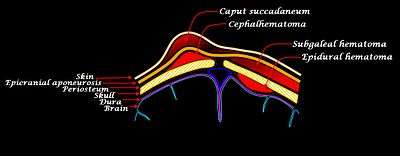Caput succedaneum
Caput succedaneum is a neonatal condition involving a serosanguinous, subcutaneous, extraperiosteal fluid collection with poorly defined margins caused by the pressure of the presenting part of the scalp against the dilating cervix (tourniquet effect of the cervix) during delivery.
| Caput succedaneum | |
|---|---|
 | |
| Newborn Scalp bleeds | |
| Specialty | Pediatrics |
It involves bleeding below the scalp and above the periosteum.[1]
Symptoms
Caput succedaneum presents as a scalp swelling that extends across the midline and over suture lines and is associated with head molding. The swelling is boggy, diffuse and not limited by suture line. Caput succedaneum does not usually cause complications and usually resolves over the first few days. It can be confused with cephalhematoma.
Management
Management consists of observation only. A complete and fast recovery will normally occur with caput succedaneum. If the baby's scalp contour has changed, a normal contour should be regained.
The baby will often be irritable so may require analgesia for its headache and handling should be kept to a minimum for the first few days.
References
- Diane Fraser (9 April 2009). Myles' Textbook for Midwives. Elsevier Health Sciences. p. 860. ISBN 978-0-443-06939-0. Retrieved 12 April 2010.